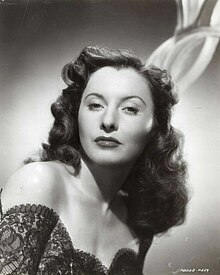| Whitey Schafer | |
|---|---|
 Schafer c. May 1936 Schafer c. May 1936 | |
| Born | Adolph L. Schafer 1903 Salt Lake City, Utah, U.S. |
| Died | August 31, 1951(1951-08-31) (aged 47–48) Bremerton, Washington, U.S. |
| Occupation | Photographer |
| Children | 1 |
Adolph L. "Whitey" Schafer (1903 – August 31, 1951) was an American photographer known for his pin-ups and glamour photography. Born in Salt Lake City, Utah, Schafer grew up in California and began working in the movies in 1921. He took still photos of movie stars for several studios, including Columbia and Paramount. Schafer was killed by an explosion on a yacht in 1951.
Early life and education
Adolph L. Schafer was born in 1903 in Salt Lake City, Utah. His parents moved to California when he was six months old. He went to high school in Hollywood, California, and attended art school at some point.
Career

Schafer began working in the film lab of Paramount Pictures in 1921. He also worked for Thomas H. Ince's studio, Cecil B. DeMille's studio, RKO-Pathé, and Columbia Pictures, where he headed the photography department as of 1938.
In 1943, and as of 1948, Schafer was the director of still photography at Paramount Pictures. A 1943 profile of Schafer, published during World War II, emphasized his role as a pin-up and glamour photographer, referring to a fictitious serviceman abroad:
He burns for one of those works to whistle over—a pin-up portrait of flowing hair, parted lips, shining shoulders and langorous [sic] look. And Whitey and the most beautiful women in the world oblige by turning out glamor art on the double run since the wartime cry for star photographs has rocketed 100 per cent by actual studio count.
A 1947 profile described Schafer's role as "to photograph hundreds of glamour queens wearing about as much clothes [sic] as normally serves the gun crew on a battleship".
One of Schafer's techniques was the use of "canned sex", a mix of petroleum jelly with "the oil that forms on top of liquid theatrical makeup", which he would put on women's shoulders to reveal "china doll highlights". According to Schafer, "canned sex" worked better than cold cream. He believed that women did not look beautiful in the morning because their eyes were not fully open at that time. His favorite photographic subject was Marlene Dietrich. He wrote a book called Portraiture Simplified, published by Ziff Davis.
In a parody of the Hays Code, Schafer's 1940 photograph Thou Shalt Not depicts a sex worker, dead policeman, and liquor.

It lists ten objects and concepts banned by the Hays Code, each of which the photo contains.
Personal life
Schafer loved silk scarves: he reportedly owned 365, one for each day of the year. His nickname came from his light blond hair. He was close friends with the actor William Boyd.
He died at Puget Sound Naval Memorial Hospital on August 31, 1951, from injuries caused by a yacht explosion in Bremerton, Washington. He was survived by his wife, Mabel, and 22-year-old son, Wayne.
Publications
- Schafer, A. L. (1941). Portraiture Simplified. Ziff Davis. OCLC 5714594.
- Schafer, A. L. Whitey (February 1943). "Explore Your Home for Pictures in Pattern". Popular Science. 142 (2): 144–147. ISSN 0161-7370.
- Schafer, A. L. "Whitey" (June 1947). "My Idea of a Beautiful Woman". Movieland. 5 (5): 59–61.
Notes
- ^ Johnson 1948, p. 138.
- Johnson, Grady (June 22, 1947). "Glamour Is His Specialty". The New York Times. ISSN 0362-4331. Retrieved October 30, 2021.
- ^ Evans 1938, p. 20.
- ^ Johnson 1948, p. 136.
- ^ Evans 1938, p. 21.
- ^ Perrigo, Lucia (July 17, 1943). "Pin-Up Pix: Here's How They 'Happen'". Republican and Herald. p. 8 – via Newspapers.com.
- Johnson 1948, p. 56.
- Koury, Phil (May 26, 1947). "12 Years Photographing Pin-Up Girls, but He Thinks His Wife in Apron Is Most Glamorous". St. Louis Globe-Democrat. p. 11 – via Newspapers.com.
- ^ Johnson 1948, p. 58.
- Johnson 1948, p. 141.
- Courtney, Susan (2005). Hollywood Fantasies of Miscegenation: Spectacular Narratives of Gender and Race, 1903–1967. Princeton University Press. p. 323. ISBN 978-0-691-11305-0.
- "Thou Shalt Not". Yank, the Army Weekly. 4 (3): 13. July 6, 1945.
- Johnson 1948, p. 57.
- "Long Time Friendship Began with Argument". Detroit Free Press. Associated Press. July 19, 1931. p. 31 – via Newspapers.com.
- "Whitey Schafer Dies of Blast Injuries". Press-Telegram. Associated Press. September 1, 1951. p. 7 – via Newspapers.com.
- "Blast Fatal to Photographer". Los Angeles Times. September 1, 1951. p. 4 – via Newspapers.com.
Sources
- Johnson, Grady (January 1948). "'Whitey' Schafer Shoots the Stars". Popular Photography. 22 (1): 56–58, 136, 138, 140–141. ProQuest 2306179888.
- Evans, Wick (June 1938). "Whitey Schafer: Hollywood's Veteran Still-Man". Popular Photography. 2 (6): 20–21, 85. ProQuest 2306108608.
Further reading
- Blasdell, George (October 1939). "How Moving Pictures Are Moved by Stills". American Cinematographer. 20 (10): 438–440.
- Bois-Smith, Murray Howard, ed. (May 1936). "'Get the Picture' Regardless of Danger Is the Still Departments Creed". Motion Picture Studio Insider. 1 (3): 33, 61.
- Mallory, Mary (November 4, 2013). "A. L. 'Whitey' Schafer Simplifies Portraits". LA Daily Mirror.